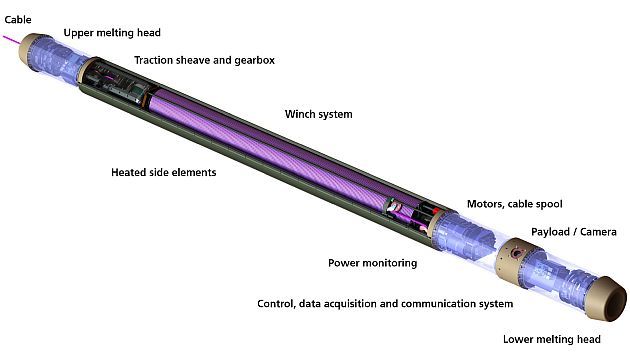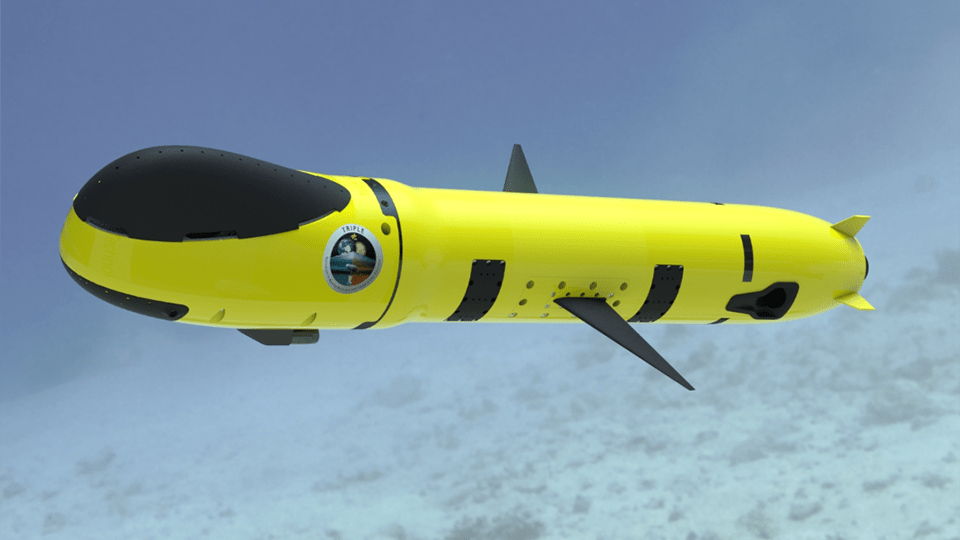The most promising places to look for life in the Solar System are in the ocean moons Europa and Enceladus. But all that warm, salty, potentially life-supporting water is under thick sheets of ice: up to 30 km thick on Europa and up to 40 km thick for Enceladus.
The main obstacles to exploring all that water are the thick ice barriers. Assuming a spacecraft can be designed and built to melt its way through all that ice, what then?
Submarines can do the actual exploring, and they needn’t be large.
European researchers involved in the collaborative project TRIPLE-nanoAUV 2 are building and testing melting probes with tiny submarines in them. The acronym TRIPLE stands for – Technologies for Rapid Ice Penetration and subglacial Lake Exploration. It’s coordinated at MARUM, the Center for Marine Environmental Sciences at the University of Bremen, Germany.
Earth holds a nearly ideal location to test and explore these submarines. Antarctica’s continental ice sheets are up to 4 km thick, and beneath that ice are subglacial lakes. Scientists think that water flows back and forth amongst this system of interconnected lakes. There are close to 400 of these buried lakes in Antarctica, and some of them may have been isolated from the outside world for over 3o million years. They could be that last stronghold for types of life not found elsewhere on Earth.
“The new autonomous system is unique and should make it possible in the future to study the global liquid-water ocean below the icy surfaces of Jupiter’s moon Europa and Saturn’s moon Enceladus.”
Professor Ralf Bachmayer, MARUM, Project Lead for TRIPLE-nanoAUV 2
If these lakes do harbour undiscovered ecosystems, then there isn’t a better analog to test machines that can melt their way through ice and then deploy submarine probes. Testing and exploring these lakes will require the same caution as exploring Europa or Enceladus, since they may also host life.
But they won’t be ready to test their small submarines for real in Antarctica until the Spring of 2026. And their first test site won’t be the subglacial lakes. Instead, they’ll start with field tests under the Ekström Ice Shelf near the Neumayer III Station, where ice is only about 100 to 200 meters thick.

The TRIPLE team will test both their small Autonomous Underwater Vehicle (AUV) and a Launch and Recovery System (LRS.) The LRS is like a mother ship. Not only will it launch and recover the AUV, but it also acts as a data download station and a recharging station. Since the AUV has to be small to travel through the ice inside a melting probe, it’s only about 50cm long and 10cm in diameter. It won’t have sustained battery power and will need to recharge to extend its exploration time.

The melting probe that carries the AUV is called TRIPLE-IceCraft and has already been developed and tested. It’s approximately four metres long, 20 centimetres in diameter and weighs almost 300 kilograms. Both the upper and lower head are heated to melt the ice, and the sides are also heated to prevent re-freezing of melted water.

Professor Ralf Bachmayer of MARUM is the TRIPLE-nanoAUV 2 project leader. “Such nano-vehicles can help to provide a better overall understanding of marine ecosystems,” Bachmeyer said. “The new autonomous system is unique and should make it possible in the future to study the global liquid-water ocean below the icy surfaces of Jupiter’s moon Europa and Saturn’s moon Enceladus. Miniaturization is the primary challenge in its development, with the probe dictating the overall size. In addition, all of the components must be able to withstand the high pressure under water.”
Sebastian Meckel is the lead engineer on the project. “The objective is to garner expertise within the DLR Explorer initiatives that could be used in a possible international space mission,” he said. “The first field tests will deploy the melting probe with the nanoAUV integrated as payload in ice with a thickness of 100 meters. In addition, the nanoAUV is underactuated compared to larger autonomous vehicles, meaning it has limited maneuverability. This necessitates an extremely high reliability and close coordination among the associates from TRIPLE-GNC and TRIPLE-LifeDetect.”
TRIPLE-GNC (Guidance and Navigation Control and TRIPLE-LifeDetect are the other parts of the TRIPLE collaboration. TRIPLE-LifeDetect is the in-situ laboratory called the Astrobiolab. TRIPLE describes it as “an innovative and highly automated sample analysis laboratory for astrobiological investigations.” For these upcoming tests, the melting problem will be too small to hold the lab, so it’ll remain on the surface as part of the ground probe. The Astrobiolab will likely contain a microscope, a Raman spectrometer, a portable mass spectrometer, and a portable DNA sequencer.
After testing in the ocean at the Neumayer III station, the TRIPLE team has their sights on Antarctica’s subglacial lakes for final testing. Their chosen target for those tests is a grouping of subglacial lakes about 3,000 km away from the Neumayer III station. The region is called Dome C, and it’s one of Antarctica’s several summits. It’s about 3200 meters (10,600 ft.) above sea level. Dome C is home to the Concordia Research Station.

If there are unknown ecosystems in Antarctica’s subglacial lakes, then the TRIPLE team says that the in-situ lab should be able to detect a diverse set of biosignatures in samples once it’s tested there. It should also detect unequivocal signs of life. So there’s more to the testing than just looking ahead to future missions to our Solar System’s icy moons and their buried lakes. The testing will give us an initial look at the frozen continent’s ancient, subsurface lakes.
Learning about an unexplored region on Earth is a rare occurrence at this stage in humanity’s existence. But what really generates excitement is the potential future use of small subs like TRIPLE-nanoAUV 2 on Europa and maybe Enceladus. Both NASA and the ESA are sending robotic probes to explore Europa and its neighbours. But they’re orbiters, not landers. Their results will no doubt be fascinating, but they’ll just whet our appetites for more.
Maybe one day, tiny submarines will finally give us the answer to our largest question: Are we alone?
TRIPLE-nanoAUV 2 is part of a larger TRIPLE effort by the DLR (German Aerospace Center) called the Explorer Initiatives. It includes TRIPLE-nanoAUV1, the precursor to the current AUV2, and TRIPLE-MoDo, the already-developed docking station for the system.

